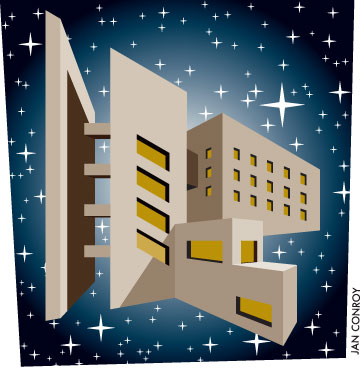Volume 24 · Number 2 · Winter 2007

Campus Views
The Love-Hate Building
Most buildings are seen but never noticed. They lend themselves to function but rarely to art. Lackluster edifices with four sides and eight corners just seem to fade into the background no matter where they are located. With its innumerable facets and distinct character, one thing is for certain: the UC Davis Social Sciences and Humanities Building designed by Antoine Predock is nothing like most buildings.
Antoine Predock’s creation is something out of an M.C. Escher fantasy. A stark, grey labyrinth, the Social Sciences and Humanities building is aesthetically estranged from a campus that is at once colorful and traditional. Of the family of buildings at UC Davis, it is the stepchild.
Its offices and rooms lack a sensible cohesion and order. It has paths that crisscross but never meet, rooms in close proximity that are not adjoined and catwalks that lead to seemingly arbitrary destinations. It is a geometric wasteland laced with asymmetry and dotted in irony. Like a run-on sentence, the pathway at the base of the structure lacks a subject and a destination: It twists, circles and repeats itself to the point of exhaustion; hidden staircases that blend into their surroundings and dizzying catwalks with glass walls are all part of the adventure.
On a cloudy day the grey spires of its loosely federated structures seem to dissolve seamlessly into the bleak heavens. A maze of steel and concrete, the spaceship-like façade has resulted in its nickname: “The Death Star.”
UC Davis Chancellor Larry Vanderhoef admits to having gotten lost in the building on a few occasions. “It takes some getting used to,” says Vanderhoef, “but once you get to know your part of the building you learn to appreciate it.
“[Predock] did things because he was interested in the sculpture, not just the function,” he adds about Predock’s technique.
Predock himself says this about his work: “When I was a student at Columbia University I became very involved in dance and with the body in space. This influenced my work profoundly. I think of my buildings as choreographic events; they are an accumulation of vantage points.”
Predock is world-renowned, heading offices in Indiana, Albuquerque, Los Angeles and Taipei. He is the recipient of many awards, most recently the coveted American Institute of Architects (AIA) Gold Medal—which honors annually an individual whose work has had a lasting impact on the theory and practice of architecture.
As I perused his online portfolio (www.predock.com), I felt as though I was flipping through the Death Star’s family photo album. Having designed buildings ranging from the Canadian Museum for Human Rights in Winnipeg to PETCO Park in San Diego, Predock has left his artistic thumbprints around the globe.
Predock’s architecture is featured on several other California campuses, including UC San Diego, UC Santa Cruz, Stanford University and Cal Poly Pomona. Predock’s giant, cathedral-like administration building at Cal Poly Pomona is commonly referred to as “the Titanic” by students and faculty. Upon hearing about the nicknames for two of his works, Predock laughs. “As an architect, you sort of put your buildings out there not knowing how people will respond. If I don’t get a strong reaction from what I do, it means that I haven’t done my job.”
His Davis building is at once bizarre, perplexing, impractical and brilliant. But some may be surprised to learn that there is a method to the madness of Antoine Predock.
“When I would fly over the San Joaquin Valley, I noticed that the San Joaquin River Delta seemed to interrupt the grid-like parcels which surrounded it,” recalls Predock. “I wanted to incorporate this sense of regional topography into the building.” Like the delta, the pathway at the base of the building is a twisted spine that connects the various departments, which are colored in varying shades of beige or gray.
The Social Sciences and Humanities building has a twin in Albuquerque, N.M. It rests on Predock’s coffee table. Predock still cherishes the miniature bronze created from the clay model he made when designing the building.
It’s a sign of his fondness for his design work at UC Davis. “That building is very special to me,” he says. “A lot of the buildings I do are very love-hate. I love this one.”
